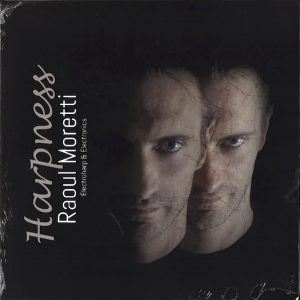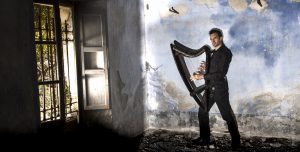Camac Blog
New horizons for Raoul Moretti
Latest
February 18, 2020
Unconventional harpist Raoul Moretti is well-known for his bold explorations with our DHC 32 electric harp. We discovered his multimedia show Harpscapes in Croatia in 2015; with electronics by Massimo Colombo and visuals by Olo Creative Farm, we liked it so much that we invited Raoul to perform it again in Paris the following season. Harpscapes was also performed further in more than 20 countries.
Raoul followed Harpscapes with Harpness (above), a darker album based on seventeen improvisations, and with strong rock influences. One hallmark of his music is that it never stands still: always seeking new styles and directions, he constantly surprises his listeners with where he takes the e-harp next. His third album, IsolaMenti, adds new colours from cello (Julia Kent), viola (Michele Gazich), vocals (Beppe Dettori), sax (Giuseppe Joe Murgia), and vibes/marimba (Marco Bianchi). Inspired by islands and the sea, Raoul sees the island as a metaphor for the creative individual, their shifting horizons before them. The music still contains improvisatory elements, but combined with more structured parts; like all Raoul’s albums, the sound processing is always recorded live. “Harpness and IsolaMenti are reflections of my interior evolution”, says Raoul. “Harpness is darker, stronger and more extreme. IsolaMenti is a synthesis, returning to something more contemplative. Together with Harpscapes, they form a kind of trilogy.”
In 2020, Raoul’s recording work is evolving still further. This is another project with singer Beppe Dettori: S’incantu e sas cordas, a Sardinian title meaning “Strings and Enchantment”. It’s a departure from the ambient electronica so present in the earlier albums; instead, it’s an experimental world music CD. “We’re combining new ways of presenting traditional songs, with a mixture of acoustic and electronic sound”, Raoul explains. “We’ve blended an Irish jig with a Sardinian dance; a variation on a Habanera by Alfredo Rolando Ortiz, with a Sardinian folk song. Again, all the sound processing is recorded live, and it forms the bases for the vocal treatment. We’re combining traditional vocals with guttural sounds and other vocalising, there’s another example.”
Raoul’s albums are available on the Camac webstore, and you can also find them on Spotify, YouTube and other digital channels.
Where next for Raoul Moretti? “I’m planning a major music+visuals installation”, Raoul confides. “I can’t tell you all about it until it’s finished, but I’m working with one of the best video artists in Italy…and we’ll be touring with it by this summer!”. To catch them while you can, keep up with Raoul on Facebook and Twitter. His Alternative Harp Spotify playlist is also a constantly-updated source of inspiration and novelty for everybody interested in uncovering new sides to the harp.
Cover photo: Fabrizio Massidda


